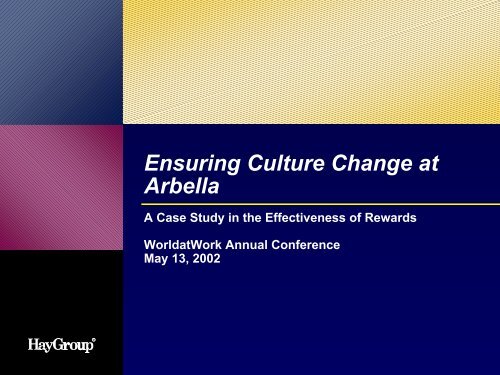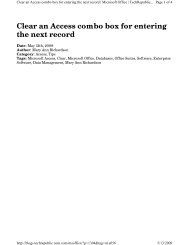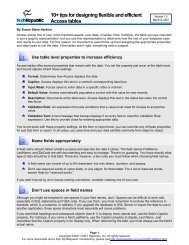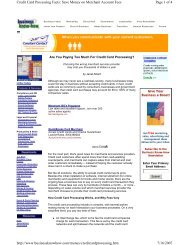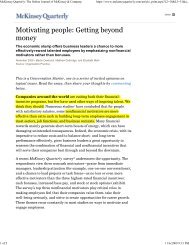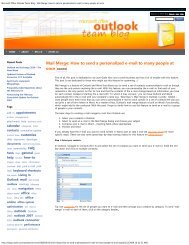Ensuring Culture Change at Arbella - Cornerstone Business Solutions
Ensuring Culture Change at Arbella - Cornerstone Business Solutions
Ensuring Culture Change at Arbella - Cornerstone Business Solutions
- No tags were found...
You also want an ePaper? Increase the reach of your titles
YUMPU automatically turns print PDFs into web optimized ePapers that Google loves.
<strong>Business</strong> Challenges 2000–2003• Str<strong>at</strong>egic Planning Exercise (November 1999):Projected revenue decreasesExpense pressures - decreasing dollars for salary budgetDesire to change compens<strong>at</strong>ion programs to recognizeperformance differenti<strong>at</strong>ionDesire to use compens<strong>at</strong>ion programs as a culture change driver®Copyright © 2002 Hay Group, Inc. All rights reserved4
Leadership Challenges• Executive team changing—widely variant expect<strong>at</strong>ionsand behavior• Differing views re: need to work on culture change• Need to agree on vision of desired culture and establishperception of current st<strong>at</strong>e st<strong>at</strong>us (November 2000)®Copyright © 2002 Hay Group, Inc. All rights reserved5
Organiz<strong>at</strong>ional Cultural Assessment• Leadership team independently completed Hay’s C-Sortdiagnostic tool• C-Sort methodology uses 56 <strong>at</strong>tributes to describeorganiz<strong>at</strong>ional cultures• Sample AttributesEncouraging teamworkSupporting the decision’s of one’s bossRewarding superior performancePushing decision making to the lowest levelsMaximizing customer s<strong>at</strong>isfaction®Copyright © 2002 Hay Group, Inc. All rights reserved6
D<strong>at</strong>a Collection• Leadership team asked to sort 56 <strong>at</strong>tributes from high to low priorityFirst, based on current cultureSecond, based on desired culturePriority 4Priority 3Priority 5Priority 2Priority 6Priority 1Priority 7High-PriorityAttributesLow-PriorityAttributesVery Frequently/A Gre<strong>at</strong> Extent/In Most Parts of the Organiz<strong>at</strong>ionSometimes/Some Extent/In Some Parts of the Organiz<strong>at</strong>ionVery Infrequently/Small Extent/In Few Parts of the Organiz<strong>at</strong>ion®Copyright © 2002 Hay Group, Inc. All rights reserved7
C-Sort Findings• Modest agreement about current culture• Strong agreement regarding desired culture• Significant gap between current and desired cultureCompared to Hay’s Norm<strong>at</strong>ive D<strong>at</strong>abaseGeneral IndustryInsurance IndustryConsensusRegardingCurrent <strong>Culture</strong>ConsensusRegardingTarget <strong>Culture</strong>Gap BetweenCurrent &Target <strong>Culture</strong>sAverage:43 rd percentileVery High:78 th percentileHigh:68 th percentileLow:25 th percentileHigh:66 th percentileHigh:63 rd percentile®Copyright © 2002 Hay Group, Inc. All rights reserved8
<strong>Culture</strong> <strong>Change</strong> Priorities:Three ElementsGre<strong>at</strong>er emphasis on performanceand less on job security, loyalty, andconsistencyMore value for flexible workenvironment and less reliance oncompliance and adherence to rigidstructures and functional hierarchiesA shift in orient<strong>at</strong>ion from internal toexternal while maintaining focus oncustomers®Copyright © 2002 Hay Group, Inc. All rights reserved9
Performance• EmphasizeBeing flexible and adaptive in thinking and approachAttracting top talentRewarding superior performanceCapitalizing on cre<strong>at</strong>ivity and talent• DeemphasizeProviding secure employmentBeing loyal and committed to the companyEstablishing clear job descriptions and requirementsNote: Attribute ranking changed by <strong>at</strong> least 2 c<strong>at</strong>egories. Emphasize<strong>at</strong>tributes appear in top 3 priority c<strong>at</strong>egories, deemphasize in lower 3 c<strong>at</strong>egories.®Copyright © 2002 Hay Group, Inc. All rights reserved10
Flexible Work Environment• EmphasizeContinuously improving oper<strong>at</strong>ionsBeing flexible and adaptive in thinking and approachUsing limited resources effectively• DeemphasizeQuality checking subordin<strong>at</strong>e’s workBeing precise; minimizing human errorMinimizing unpredictability of business resultsUsing proven methods to serve existing marketsRespecting the chain of commandSupporting decisions of top management and of one’s bossMaintaining clear lines of authority and accountabilityEstablishing clear job descriptions and requirements• Maintain EmphasisEncouraging teamwork®Copyright © 2002 Hay Group, Inc. All rights reserved11
Orient<strong>at</strong>ion• EmphasizeProviding employees with resources to s<strong>at</strong>isfy customersDelivering reliably on commitments to customers• DeemphasizeUsing proven methods to serve existing markets• Maintain EmphasisMaximizing customer s<strong>at</strong>isfactionDemonstr<strong>at</strong>ing understanding of customer point of viewMaintaining existing customer accountsResponding to customer feedback®Copyright © 2002 Hay Group, Inc. All rights reserved12
<strong>Culture</strong> <strong>Change</strong> & Rewards:BackgroundPrior to project, compens<strong>at</strong>ion systemcharacterized by:• Competitive salaries• Traditional grade structure• Grades based on job evalu<strong>at</strong>ions• Very little differenti<strong>at</strong>ion in merit payMerit m<strong>at</strong>rix guidelines• Modest ($200) bonus opportunitybelow management, based oncompany performanceEntitlementInternally-focusedControl orientedRigid structures®Copyright © 2002 Hay Group, Inc. All rights reserved13
<strong>Culture</strong> <strong>Change</strong> & Rewards:Background• No opportunity to enhance competitiveness due tobudget constraints• Needed to better leverage existing investment• Base and merit pay was logical choice• Decided to stop tre<strong>at</strong>ing merit like a taxPaying it is inevitableYou don’t see anything in return®Copyright © 2002 Hay Group, Inc. All rights reserved14
<strong>Culture</strong> <strong>Change</strong> & Rewards:BackgroundSalary increases are one of <strong>Arbella</strong>’s largestannual expenditures<strong>Arbella</strong> Merit 1040 FormLine 1: Total Payroll………………… $52,000,000Line 2: Total Merit Budget…………. 4.5%Line 3: Promotion Budget…………. 0.5%Line 4: Other Out-of-Cycle………… 0.0%Line 5: Total Expense………………. $2,600,000Line 6: Total Return…………………. ???®Copyright © 2002 Hay Group, Inc. All rights reserved15
<strong>Culture</strong> <strong>Change</strong> & Rewards:The Opportunity• Wh<strong>at</strong> was <strong>Arbella</strong> getting in merit ROI?“I get to keep my people”• Wh<strong>at</strong> should management expect to get in merit ROI?“I get to recognize my best performers”“I retain my top contributors”“It puts the ‘teeth’ in our performance-based culture”“It facilit<strong>at</strong>es management discussion of talent”“It builds teamwork”“It improves returns on other reward programs”®Copyright © 2002 Hay Group, Inc. All rights reserved16
Reward Objectives• <strong>Culture</strong> FindingsPerformanceFlexible work environmentOrient<strong>at</strong>ion• Competitive FindingsWithin competitive normsLower on variable pay• Reward Objectives• Maximize return on compens<strong>at</strong>ion investment• Place more value on individual performance• Support cross-functional teamwork and performance• Invest in manager development®Copyright © 2002 Hay Group, Inc. All rights reserved17
Reward <strong>Change</strong>s• Reward ObjectivesMaximize return on compens<strong>at</strong>ion investmentPlace more value on individual performanceSupport cross-functional teamwork and team performanceInvest in manager development• Proposed Reward <strong>Change</strong>sNew salary structureNew merit pay program<strong>Change</strong> incentive plansManagement training®Copyright © 2002 Hay Group, Inc. All rights reserved18
Reward <strong>Change</strong>s• Place more value on individual performance<strong>Change</strong> merit increase to better reward top performers– e.g., Goal: upper quartile merit increases average 7% (assuming4% budget)Simplify job classific<strong>at</strong>ion system– Method: Reduce numbers of levels and titles– Objective: Reinforce importance of broader role Vs. finite jobsand individual contribution Vs. job value®Copyright © 2002 Hay Group, Inc. All rights reserved19
Reward <strong>Change</strong>s: New Merit PayProgramUnbundled the Merit Program• Merit pay (equivalent to cost of labor changes)• Merit plus pay (true merit)%Popul<strong>at</strong>ion2001Merit Pay2001 Merit PlusPayTotal AverageIncreaseObjective• Recognize steadyperformers• Ensure pay remainscompetitive• Reward topcontributors• Align pay withperformanceSteadyPerformersTopContributors• 75% 3.5% + 0% = 3.5%• 25% 3.5% + Average: 4%* = 7.5%Total Cost 3.5% + 1% = 4.5%2001 salaryincreasebudget* Individual increase in excess of 15% tre<strong>at</strong>ed as an exception®Copyright © 2002 Hay Group, Inc. All rights reserved20
<strong>Culture</strong> & Reward <strong>Change</strong>s:Implement<strong>at</strong>ionPreceded reward changes with managementcommunic<strong>at</strong>ion and training• All managers’ meeting sharing cultural findings and rewardchanges• Training on new reward and merit pay programIdentifying merit plus candid<strong>at</strong>esCommunic<strong>at</strong>ing new reward philosophy to employees®Copyright © 2002 Hay Group, Inc. All rights reserved21
®2001 Merit Increase Distribution:Actual70%Actual Merit Increases(Average: 4.7%)60%50%40%30%23% received <strong>at</strong>least a 7% increase% of Popul<strong>at</strong>ion20%10%15.250%Note: Actual size of merit are within +/- .25% of figures shown% IncreaseCopyright © 2002 Hay Group, Inc. All rights reserved22
<strong>Culture</strong> <strong>Change</strong>: Two Years Into The<strong>Change</strong>• Wh<strong>at</strong>‘s working well (November 2001):Customer service focus has not diminishedLine management sees progress toward desirable cultural <strong>at</strong>tributesExecutives perceive culture has shifted significantly towardperformance/process orient<strong>at</strong>ionManagement has little trouble making distinctions between levels ofperformanceManagement generally supportive of changes®Copyright © 2002 Hay Group, Inc. All rights reserved23
<strong>Culture</strong> <strong>Change</strong>: Wh<strong>at</strong> Needs MoreWork (May 2002)• Keeping executive management engaged• Cultural change is a leadership process, not an HR orcompens<strong>at</strong>ion program• Empirical d<strong>at</strong>a around cultural <strong>at</strong>tributes• Assisting line management in using performancediscussions to make differenti<strong>at</strong>ion - not tenths of merit %®Copyright © 2002 Hay Group, Inc. All rights reserved24
<strong>Culture</strong> <strong>Change</strong>: Results So Far• Line management sees progress on desirable cultural<strong>at</strong>tributes• 30% of staff were design<strong>at</strong>ed “significant” performers• Compens<strong>at</strong>ion spending was directly on budget for ’01®Copyright © 2002 Hay Group, Inc. All rights reserved25
Group View of Target Work <strong>Culture</strong>®“Our Desired or Ideal <strong>Culture</strong> WouldReward, Encourage and Support theFollowing Behaviors and Activities . . .”Maximizingcustomer/agents<strong>at</strong>isfactionDemonstr<strong>at</strong>ingunderstanding ofthe customer’spoint of viewDelivering reliablyon commitments tocustomer/agentEncouragingteamworkBeing flexible andadaptive in thinkingand approachAttracting toptalentResponding tocustomer/agentfeedbackMaintainingexisting customeraccounts/agentaccountsProvidingemployees withresources tos<strong>at</strong>isfycustomers/agentsRewardingsuperiorperformanceUsing limitedresourceseffectivelyContinuouslyimprovingoper<strong>at</strong>ionsVery Frequently/To a Gre<strong>at</strong> Extent/In Most Parts of the Organiz<strong>at</strong>ionAdapting quicklyto changes inbusinessenvironmentGaining theconfidence ofcustomersCapitalizing onwindows ofopportunityAnticip<strong>at</strong>ingchanges in thebusinessenvironmentTaking initi<strong>at</strong>iveApplyinginnov<strong>at</strong>ivetechnology to newsitu<strong>at</strong>ionsTre<strong>at</strong>ingemployees fairlyand consistentlyCapitalizing oncre<strong>at</strong>ivity andinnov<strong>at</strong>ionPushing decisionmakingto thelowest levelsEncouraginginnov<strong>at</strong>ionSometimes/To Some Extent/In Some Parts of the Organiz<strong>at</strong>ionCopyright © 2002 Hay Group, Inc. All rights reserved26
Target <strong>Culture</strong> Behaviors Th<strong>at</strong>Characterize <strong>Arbella</strong>Responding toCustomer FeedbackMaximizingCustomerS<strong>at</strong>isfactionDelivering Reliablyon Commitments toCustomers/AgentsTre<strong>at</strong>ing EmployeesFairly & ConsistentlyDemonstr<strong>at</strong>ingUnderstanding of theCustomers/AgentsPoint of ViewContinuouslyImproving Oper<strong>at</strong>ionsMaintaining ExistingCustomer/AgentAccountsEncouragingTeamworkGaining theConfidence ofCustomers/Agents®Copyright © 2002 Hay Group, Inc. All rights reserved27
Target <strong>Culture</strong> Behaviors Th<strong>at</strong>Sporadically Characterize <strong>Arbella</strong>Using LimitedResources EffectivelyRewarding SuperiorPerformanceTaking Initi<strong>at</strong>iveAnticip<strong>at</strong>ing <strong>Change</strong>sin in <strong>Business</strong>EnvironmentAdapting Quickly to to<strong>Change</strong>s in in <strong>Business</strong>EnvironmentEncouragingInnov<strong>at</strong>ion®Copyright © 2002 Hay Group, Inc. All rights reserved28
Target <strong>Culture</strong> Behaviors Th<strong>at</strong> Are NotYet Characterized By <strong>Arbella</strong>Attracting Top Top Talent TalentBeing Being Flexible &Adaptive in in Thinking& ApproachProviding Employeesw/ w/ Resources to to S<strong>at</strong>isfy S<strong>at</strong>isfyCustomers/AgentsCapitalizing on onWindows of of OpportunityApplying Innov<strong>at</strong>iveTechnology to to New NewSitu<strong>at</strong>ionsCapitalizing on onCre<strong>at</strong>ivity &Innov<strong>at</strong>ionPushing Decision-Making to to the theLowest Levels Levels®Copyright © 2002 Hay Group, Inc. All rights reserved29
In Summary• Significant progress has been made• More progress is needed• Rewards can help, but can’t do it alone• Building a business case for change is crucial• Invest in managers to sustain change®Copyright © 2002 Hay Group, Inc. All rights reserved30
<strong>Ensuring</strong> <strong>Culture</strong> <strong>Change</strong> <strong>at</strong><strong>Arbella</strong>A Case Study in the Effectiveness of RewardsWorld<strong>at</strong>Work Annual ConferenceMay 13, 2002


